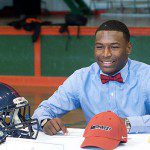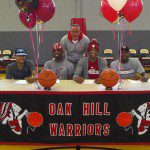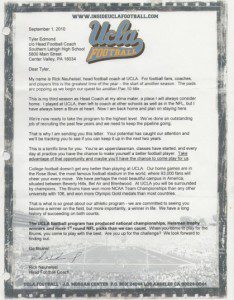Author Archive
Blake McNamara Feature Athlete Interview – Committed to Wheelock College
Posted by SportsForce in Basketball, Commitments, Recruiting, tags: Basketball, Commitments, RecruitingWe want to congratulate Blake McNamara on signing with Wheelock College. Here is Blake’s recruiting story and interview from after he committed. We wish Blake the best as a Wheelock Wildcat!
1. Share your recruiting story and status (what was the process like?)
On April 29, I committed to Wheelock College. I phoned the coach and infomed him of my decision. The process was exciting. I really enjoyed conversing with College coaches and recruiter (asst. Coaches). I went on several visits to different schools to get a feel for the campus, the coaches, etc. each time my family and I were invited to watch the team play. That piece gave me a real good idea of what type of players the coaches recruit as well as the coaching styles.
2. What school are you going to, and why did you choose them?
I choose Wheelock because their collegiate Basketball program is top notch. What I mean by that is the Coach LeVangie is great, he truly invests himself in each player and took a great deal of time to meet with myself and my family. Coach LeVangie meets with players once per week to check in on their academic load and how it’s going, he looks out for his team and it is a comforting to know he has your back. The campus is nice and right in the heart of Boston, it is in the “Fenway Five” district (5 area colleges in the consortium).
3. How did SportsForce help in the process?
SportsForce was instrumental in getting my video and portfolio out to college coaches. They assisted me every step of the way, with making the video, providing guidelines for my initial and consequent contact with college coaches, offered advice for my college visits and meetings with coaches. SportsForce was great!
4. What advice would you give to other players and parents with the recruiting process?
Get your emails out early to college coaches, contact as many coaches as possible. Some colleges that I added to my list later in the year meant that the deadline to apply to the school had passed. Send emails early and leave enough time to visit the school and apply. Many deadlines for applications are the beginning of Jan or Feb.
5. How excited are you on your future in college?
I am very excited to take my basketball career to the next step and play at the collegiate level. This is something that every boy dreams of and now my dream has come true, with a lot of hard work and help from SportsForce!!!
6. How much money do you anticipate your family saving in college expenses?
I am not exactly sure how much money I saved as a result of basketball but my parents estimate it to be around $35,000 – $40,000 (over the 4 years). The money at Division III does not come directly from athletic funds or scholarships but is rolled into the financial aid package.
7. Would you recommend SportsForce to any other student-athletes? Why?
I would recommend SportsForce to any high school athlete who has the desire to play ball at the collegiate level. They are helpful in a variety of ways and the money you put into the program comes back around, for just under $500 my family is saving an upward of $35,000 and to play ball at the collegiate level……PRICELESS!!!
Over the last five years SportsForce Recruiting has helped over 1,000 student-athletes and families successfully navigate the college recruiting and athletic scholarship process while saving families on average $50,000 in college expenses.
Finding the right college fit
Posted by SportsForce in Planning, Prep, Recruiting, Uncategorized, tags: college decision, college recruiting, finding the right college fit
Finding the right college fit can be one of the most difficult tasks in the college recruiting process…
However, once you do, it will be one of the most rewarding decisions you make in your entire life!
You’ll need to consider everything from athletics, academics and location to the financial costs and social atmosphere of each school. All this criteria goes into creating your college target list and what you and your family should consider when making a decision before you even contact a school.
All these tools are in our College Recruiting Resources Section.
EXAMPLE CASE: Let’s say you’re a student who has a 3.0 GPA and a 1400 SAT score. Those are solid marks, but not in the upper ranks for academics. Likely, that student-athlete and family shouldn’t target Ivy League schools or schools like Stanford or UCLA on the West Coast. Rather, you should do some research and determine what schools are a better fit for you both athletically and academically.
ACADEMICS
There are some great websites like collegeboard.com that can help you determine what schools might be a great fit for you to attend.
Keep in mind if you are being actively recruited, you don’t have to have the same grades that are required for the listed academic requirements for most schools.
ATHLETICS
Athletically, the best thing you can do is to go out and see a college team play, or watch them on TV to see the caliber of play and if you are capable of developing into that caliber an athlete.
Visiting the athletic website for each college is a must as well.
Here you’ll want to look for the following:
– Get an idea of the type of roster they have and what positions are already filled
– See what their depth chart looks like
– Take note of what the backgrounds of the players are. Were they All-League in high school? All-County or All-State?
Remember, it’s great to dream and have a vision for your career, but it’s also important to be realistic and use your time wisely when you’re looking at the college decision and college recruiting process.
You can get started today by getting a personal scouting evaluation – CLICK HERE TO GET STARTED
Are You Being Actively Recruited to Play College Sports?
Posted by SportsForce in College, Recruiting, tags: Actively Recruited, College Recruiting Letters, College Sports, College Sports RecruitingWhat does it mean to get actively recruited?
This is a topic that constantly pops up when our team of college recruiting advisors has conversations with college coaches and student-athletes and their families.
Most families think their child is getting actively recruited if they are receiving emails or letters. This is WRONG and a common myth that continues to exist in the college recruiting process. Being actively recruited depends on where you’re at, freshman, sophomore, junior, or senior year.
“Blanket” emails and letters are being sent to often hundreds, and sometimes thousands, of student-athletes by individual college coaches.
Here’s an example “blanket” email (Click on the image to enlarge):
After July 1st of your junior year, college coaches are allowed to call you. If you’re a junior or senior and you are aren’t receiving phone calls, and still just receiving emails or letters in the mail, that means you’re not being actively recruited.
Getting actively recruited is a common myth that usually costs many student-athletes the chance to maximize their college recruiting opportunities.
View the quick video below to hear SportsForce Recruiting’s founder and CEO Andrew Beinbrink explain the importance of being actively recruited and describe a real life example of one of our college recruiting experts. (View Nate Nelson’s story below)
A Real Life Example of NOT Being “Actively Recruited”
One of our college recruiting advisors, Nate Nelson, who played football at UC Davis, tells this story over and over again. He came out of San Diego as a pretty solid football player. He started getting letters as a sophomore and as a junior. He thought, “Oh this is great, I’m going to get recruited my senior year!” Next thing he knows, his senior year season has gone by. It’s the spring after his senior year of football and he’s got nothing. There are no offers. No schools are interested, no opportunities, and he’s scrambling to find a school that would be a good fit for him.
Now, understand this, he had received letters before his senior year from UCLA and from USC, and they fell off. It just didn’t happen. The bottom line is he wasn’t on their recruiting board. He was never getting actively recruited…
What was actually happening is, he was being marketed to by these various college programs. The school that he ended up going to was a Division I-AA school called UC Davis. It ended up being the exact right fit for him both athletically and academically.
It ended up being a great choice for him. However, the stress that he and his family had to deal with as being an unsigned senior was almost unbearable. This is what we try to help avoid.
Breaking Down Categories for Your College Target List
Posted by SportsForce in Academics, College, Planning, Prep, Uncategorized
Hopefully you have created your college target list. If you haven’t started your college target list yet, click here to see how to easily get started.
Once you have started your college target list you should really go through all of your schools and start ranking them based on how they score on some important decision factors. Click here to review the different decision factors you should be using to help you create and rank your college target list.
The next step for managing your college target list is to use the different decision factors and start identifying which category to place each school in: Reach, Target or Safety. We recommend that each category should have at least 5-10 schools.
In order to determine which category each school falls into, it is important to know which each category really means. Below we have broken down each category and provided some additional information to help you identify which schools belong in each category:
Reach Schools
Definition: A reach school is a college that you have a chance of getting into, but your test scores, class rank and/or high school grades are a bit on the low side compared to the school’s profile.
These are schools that you just might get into. These are labeled your dream or reach schools for a reason. While you may fall short on some of the requirements you could try to make up for it in other areas.
Expect strong competition for your reach schools and make sure to manage your expectations when applying to these schools. Your odds might not seem great, but you need to make sure you apply to your reach schools. You definitely won’t get in if you don’t apply!
Target Schools
Definition: A target school is a college that you are pretty likely to get into because your test scores, class rank and/or high school grades fall in line with school’s profile.
These are schools that you should feel pretty confident that you will be accepted to. Your target schools should be places that you really want to go to. You should meet all or at least most of the requirements and test scores for these schools.
Be sure to consider multiple factors when reviewing the schools profile. Your location could play a key role as State schools often favor in-state students. If you are applying to out-of-state schools, you may need to exceed the requirements.
Safety Schools
Definition: A safety school is a college that you will almost certainly get into because your test scores, class rank and/or high school grades are well above average when you are reviewing the school’s profile.
These schools you should feel the most confident about: You are going to get in! These aren’t your dream schools, but you should have some interest in your safety schools. You should be on the high end or exceed all of the requirements for these schools.
It’s important to have your safety schools just in case you don’t get into your reach and target schools. Your safety schools might provide other criteria that is more beneficial for your family (i.e. less expensive than your target and reach schools). They may also offer a scholarship or other perks that weren’t available at your other target schools.
Additional Advice:
Don’t Forget to do Your Research
•We recommend using a “bottom up” approach while making your college target list. While determining your reach schools is important, you should first focus on finding the schools that fall under your safety and target criteria.
•Understand your eligibility for admission at a particular school by getting familiar with the school’s admitted student profile.
Be Well Rounded
•While you may fall short on some requirements, you can make up for it other areas.
•Athletics can help lower the requirements in other areas.
•Volunteer Work, extracurricular activities and involvement in school organizations are also other great ways to boost your opportunities
Separating your schools will help you manage your expectations throughout the admissions process. It will help ensure you set some ambitious goals for yourself, but you also give yourself some back up options as well.
Tell us how your target list and different categories are coming along. Leave us a comment in the comments section below.
Important Decision Factors to Review while Creating Your College Target List
Posted by SportsForce in College, Planning, Prep, Recruiting
We have been stressing the importance of creating your college target list. It is the first step in preparing for the college recruiting process. We recently went over how you can create your target college list and how to rank the schools that you add to your list.
Below is a breakdown of some important decision factors for you to consider when you are creating your college target list.
Important Factors to Consider:
Athletics:
- How large is the roster?
- Which division do they compete in (NCAA DI, DII, DIII, etc.)?
- Are there athletic scholarships available? If so, how many?
Click Here to view the scholarships available for your sport in each division
Academics:
- What is the academic reputation of the school? Is it competitive or relaxed?
- What are the entrance requirements – SAT scores, AP courses, GPA minimum?
- Does the school offer the major or program you’d like to pursue?
If you’re unsure about your future, does the school offer plenty of options?
Cost:
- How much is your family willing to pay for college?
- Are you relying on athletic scholarships or financial aid?
- Will you be paying out-of-state or in-state tuition?
Location/Size:
- How far away from home do you want to be?
- Do you prefer a big city or a small town?
- Do you prefer a large, fast paced environment or small, more personalized attention?
Small: less than 2,000 students
Medium: between 2,000 and 10,000 students
Large: more than 10,000 students
As you can see, there are several very important factors to consider when developing your college target list. It is essential for you review and discuss which factors are the most important for you and your family.
Tell us which decision factor(s) are the most important to you and how they have helped shape your college target list. Leave us a comment in the comments section below.
As you continue through the decision making process, chances are you are overwhelmed by a never-ending list of colleges. There is a lot of stress that comes along with trying to figure out the ONE school that is right for you.
College isn’t just a 4 year decision… It’s a choice that will impact the rest of your life!
In order to help ease your anxiety, we’ve created a simple guide to help you narrow your search, create your target list, and pinpoint that perfect school.
Step 1: Create a list of target colleges
We recommend creating a list of target colleges and putting them into 3 different groups:
Group #1: Reach schools
These schools would have a very high ranking in almost all of the decision making factors that are part of your college decision (see below)
We recommend 10 – 15 schools in this group.
Group #2: Target schools
These schools would have a strong ranking in almost all of the decision making factors that are part of your college decision (see below)
We recommend 10 – 20 schools in this group.
Group #3: Back up schools
These schools would have an average to good ranking in most of the decision making factors that are part of your college decision (see below)
We recommend 10 – 15 schools in this group.
Step 2: Ranking target colleges
Create a list of all of your key decision making factors and give 1 to 5 points for each decision factor (5 being an extremely important decision factor).
Potential decision factors include:
• Academics (Majors offered, career development, alumni)
• Athletics (level of competition, W/L record, tradition)
• Social environment
• Size of school
• Public vs. Private
• Cost
• Coaching Staff
• Location
• Intuition (gut feeling, emotional connection)
We recommend doing this on a spreadsheet and then ranking the potential colleges you are interested in by using this system to create an overall point total for each school.
Once you have created and prioritized your college target list, you will be much more organized and can start setting up your game plan. Remember, it is very important to examine many different factors when setting up your target list.
Be sure to include your family in the decision making process, as this is a huge decision that will impact you and your family for the rest of your life…
How’s your college target list coming along so far?
Be sure to share your story in our comments section below.
Rachel Martin Feature Athlete Interview – Signed with Oregon Institute of Technology
Posted by SportsForce in Basketball, College, Commitments, High School, Q & A, Recruiting, Social Media, Tips & Advice, tags: college basketball, college recruiting, Girls Basketball, high school basketball, Rachel Martin, sportsforce, sportsforce recruiting, sportsforceonline.com, Womens Basketball

Rachel Martin
1. Why did you decide to sign with Oregon Institute of Technology?
I chose this school because of the strong academic programs provided and the incredibly high job placement rate. I loved being on campus, I enjoy the coach, and it felt right to be there.
2. Describe the excitement you feel about becoming a college student-athlete?
I am very excited about the opportunity to be a college student-athlete. It’s something that many people do not experience, and I am thankful that I am one that does.
3. What advice would you give to other athletes looking to get recruited?
I would just let them know that if you have an offer early from a school you love, it’s okay to sign early.
4. Who has been the biggest influence in your sports career and why?
My dad has been my biggest influence because he he has spent hours practicing with me and pushes me to be the best I can be.
5. What would you like to accomplish during your college sports career?
I want to improve over the next four years.
Over the last five years SportsForce Recruiting has helped over 1,000 student-athletes and families successfully navigate the college recruiting and athletic scholarship process while saving families on average $50,000 in college expenses.
College Baseball Recruiting – Scholarships and the Competition
Posted by SportsForce in Baseball, Coaching, College, High School, News, Recruiting, Tips & Advice, Training, tags: athletic scholarships, Baseball, Baseball prospects, baseball recruiting, college baseball, college recruiting, D1, D2, D3, high school baseball, NCAA, NCAA Recruiting, scholarships, sportsforce, sportsforce recruiting, sportsforceonline.com


A lot of the questions we receive here at SportsForce Recruiting have to do with athletic scholarships. As you are probably finding out the hard way, the college recruiting process can be very difficult and confusing. A lot of the confusion comes from athletic scholarships and what is actually available for student-athletes in their perspective sports.
Many families are very stressed over finding athletic scholarships! To help families alleviate the stress, and have a better understanding about athletic scholarships, we have created our Athletic Scholarships Available Guide.
Over the next couple of weeks we are going to take a closer look at specific sports and breakdown what scholarships are actually available and the competition for these scholarships.
We’re going to start off by taking an in-depth look at College Baseball Recruiting.
While there are a decent amount of baseball scholarship opportunities available at the NCAA, NAIA, and NJCAA levels, there is also an abundance of talented high school baseball players competing for all of these different scholarship opportunities.
Below is a chart that shows all of the schools that offer baseball and the baseball scholarships that are available at each level:
| Division | Schools Offering Baseball | # of Scholarships per School | Total Scholarships Available |
| 1 | 298 | 11.7 | 3451.5 |
| 2 | 259 | 9 | 2331 |
| NAIA | 212 | 12 | 2544 |
| NJCAA | 511 | 24 * | 12264 * |
| Totals | 1280 | Varies | 20590.5 * |
*Number of scholarships varies
*** Division 3 schools don’t offer athletic scholarships ***
Baseball Participation by the Numbers:
- 473,500 baseball players at the high school level
- 10,400 go on to play DI baseball (About 2% of all HS players)
- 20,200 go on to play DII or DIII baseball (About 4% of all HS players)
- 6,300 go on to play NAIA baseball (About 1% of all HS players)
- 15,300 go on to play at Junior College (About 3% of all HS players)
In summary, only about 11% of all high school baseball players actually end up playing some level of college baseball.
So, not only is the recruiting and athletic-scholarship process confusing, but it is also super competitive! That is why it is very important for you to understand where you stand in the college recruiting process and what schools you should be realistically going after when you are creating your college target list.
A few tips for maximizing your scholarship opportunities:
- Scholarships aren’t based solely on talent
- Schools also make their “target list” and look for athletes that will be a good fit
- Many schools are looking for athletes that have a good academic standing
- “Full Ride” scholarships are VERY RARE – partial scholarships are more likely
- There are many more opportunities outside the top Division I schools
- If you are looking to walk on, there are still scholarship opportunities available
- BE OPEN to all levels of competition to maximize your opportunities
Remember, even though the recruiting and scholarship process is difficult and confusing, it doesn’t mean you have to go through it alone! We are here to help provide you with expert guidance and the tips and tools necessary to maximize your opportunities.
Over the last five years SportsForce Recruiting has helped over 1,000 student-athletes and families successfully navigate the college recruiting and athletic scholarship process while saving families on average $50,000 in college expenses.
Jessica Donnelly Feature Athlete Interview – Signed with Hesston College
Posted by SportsForce in College, Commitments, High School, Inspiring Stories, Recruiting, Soccer, tags: college recruiting, College Soccer, girls soccer, hesston college, High School Recruiting, High school Soccer, jessica donnelly, sportsforceonline.com, womens soccer


1. Why did you decide to sign with Hesston College?
They actually found me–and it was a blessing! The soccer coach found me on berecruited.com. I decided to sign my letter of intent with Hesston College for many reasons. I wanted to attend a small college–most of my friends were going to OSU or U of O, both sporting over 25,000 students. Hesston only has 450 students enrolled. I wanted the lifetime experience of attending a school in a different state, a different geographical location, and I wanted to experience something that I have never experienced before. Hesston had everything I wanted all wrapped up in a bow.
2. Describe the excitement you feel about becoming a college student-athlete?
Excitement, are you kidding? It was beyond excitement, beyond words. I wish everyone could experience the thrill that I had when I heard that I received not only a soccer scholarship, but an opportunity grant on top of it. I was delighted. My dream was not only to attend college, but to also play soccer. This is a huge dream come true for me!
3. What advice would you give to other athletes looking to get recruited?
Don’t give up. Start early with having your parents videotape your games. If possible take only about 10 minutes of total video and some still shots and add some stats and facts about yourself. Don’t let anyone take your dream away from you and if one coach doesn’t think you have the skills or the speed, don’t let them discourage you. Sometimes their judgment of your abilities could be wrong, so keep practicing, training, stay clean and keep up your schoolwork. Eventually your hard work will pay off.
4. Who has been the biggest influence in your sports career and why?
Probably my parents–they went to every single game and practice, washed my practice gear, and made sure I had every opportunity to achieve my dream goal of playing college soccer.
5. What would you like to accomplish during your college sports career?
I would love to be picked up by a 4-year school. Currently, I will be playing for Hesston College in Kansas, which is only a 2-year private school. I would love to play for a D-3 or D-2 school; because of my height I doubt that I will be able to play D-1. But for now I am good, and am happy that I’m playing!
Over the last five years SportsForce Recruiting has helped over 1,000 student-athletes and families successfully navigate the college recruiting and athletic scholarship process while saving families on average $50,000 in college expenses.











